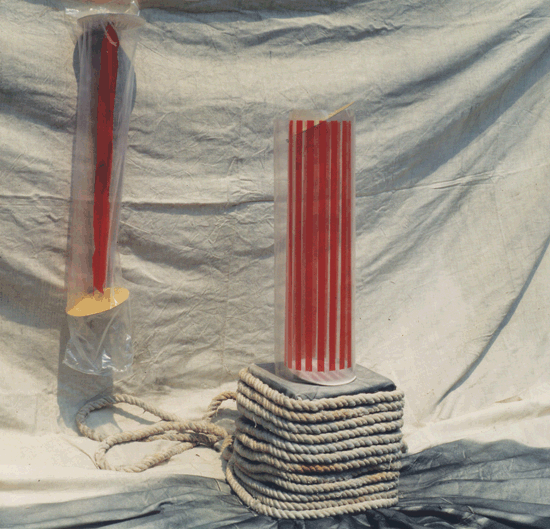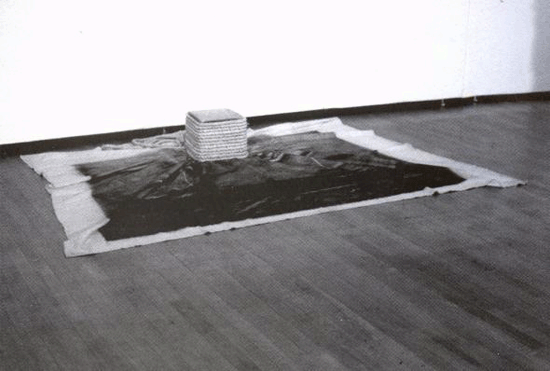Object & Installation

형의 상관
1973, 한지 3장, 흙, 캔버스 틀 4개, 4점 시리즈, 각각 약 65x65cm
1973년 강국진은 ‘형의 상관’이라는 주제로 한지, 흙, 로프, 나무 등 다양한 사물들이 장소 속에서 어떻게 관계하는지를 탐색하는 첫 개인전 (1973.9.27-10.1)을 명동화랑에서 열었다. 1970년대 초엽 AG(한국아방가르드협회) 전시에 ‘사물들의 상관 관계’라는 문제와 ‘장소성’에 대해 탐색하는 작품들이 포함되기도 했고, 1973년 파리 비엔날레에 이건용과 심문섭이 설치작품을 출품했던 때였다. 그러나 강국진처럼 개인전을 통해 집중적인 모색을 했던 작가는 국내에 거의 없었다. 이 작품은 제1회 개인전(명동화랑, )에서 한지와 흙을 사용했던 여섯 점의 시리즈 작품, <형의 상관>과 맥락을 같이 하는 개인적인 실험이다. 이미지 맨 앞쪽의 3점은 캔버스 틀에 한지를 깐 뒤, 다양한 형태로 흙을 올려놓았고 마지막 네 번째의 캔버스 틀에는 흙만 채워 놓았다. 그것은 다양한 형태를 지닌 물질로서의 흙과 한지, 그리고 캔버스 틀의 조형적 상관 관계에 대해 탐구했던 작품이며, 그는 한지와 흙이라는 물질과 함께 회화의 도구로서의 캔버스가 아닌 ‘물질로서의 캔버스 틀’에 주목했다. (김미경, 미술사학 박사 / 강남대 교수 / 한국예술연구소KARI 대표)
Interrelation of Forms
1973, 3 Korean papers, soil, 4 canvas frame, 4 series, 65x65cm each.
In 1973, Kukjin Kang opened his first personal exhibition ‘Interrelation of Forms’(27 September-1st October) to ponder upon the relations of multifarious materials within a certain spatial realm, using Korean papers, soil, ropes and wood. It was held in gallery Myungdong and included various works that resembled or reminiscent of those he displayed for Korean Avant Garde Association in the early 70s. This was the time when Kang also worked together with Kunyong Lee and Moonseup Shim for Paris Biennale, namely their installation project. But this particular personal exhibition deserves an attention in that there had been hardly any Korean artist at the time, who used the sort of opportunity to properly explore the subject. Concerning the very first three pieces in the photo respectively, 6 sheets of Korean paper is laid onto the canvas frame and lumps and dusts of soil are placed in various shapes and forms. The fourth canvas contains some soil in no particular form. This work of Kang focused on the interrelations between different materials which are easily variable in shape and form and the utilizability of canvas not as a tool of painting but as an independent material. (Mikyung Kim / Professor of Art History at Kangnam University / Director of Korean Art Research Institute)
KUKJIN KANG









